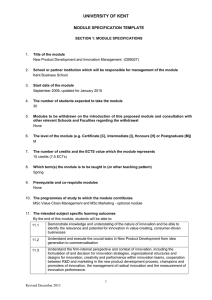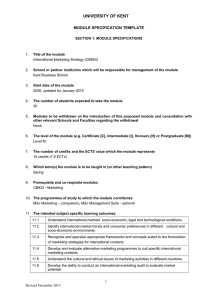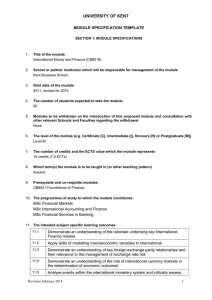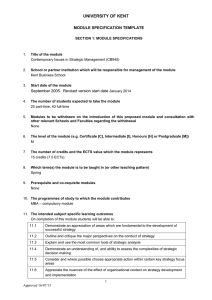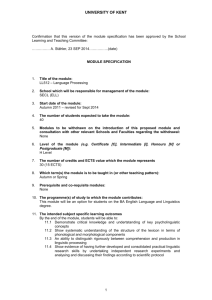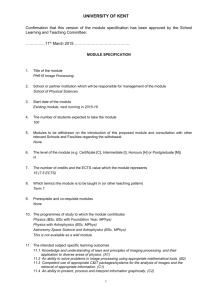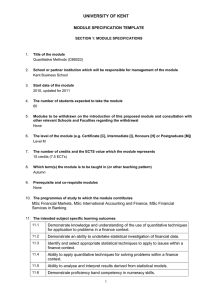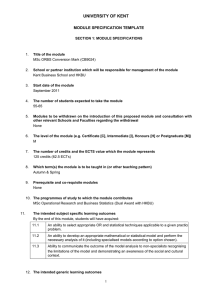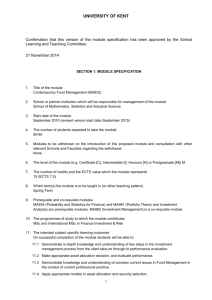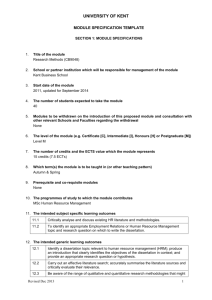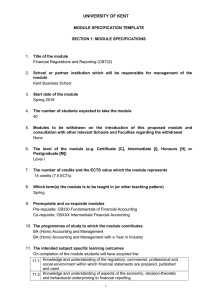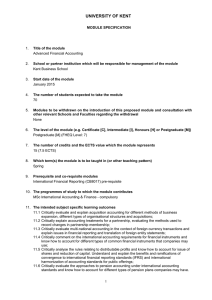Linear Programming and Its Application (CB668)
advertisement
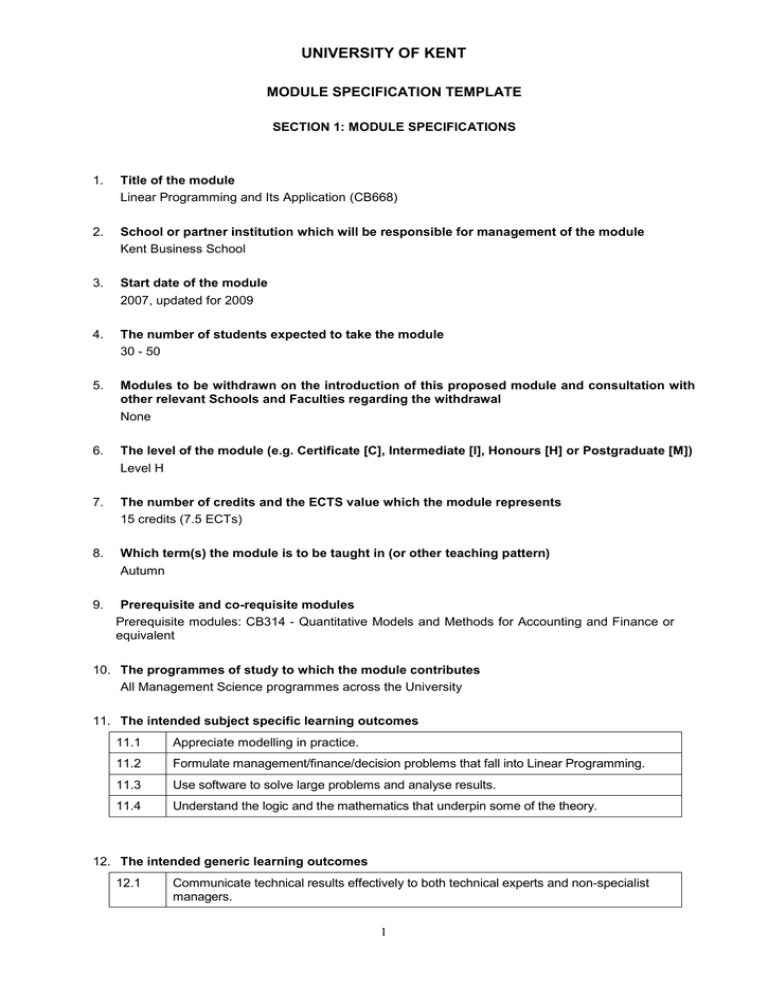
UNIVERSITY OF KENT MODULE SPECIFICATION TEMPLATE SECTION 1: MODULE SPECIFICATIONS 1. Title of the module Linear Programming and Its Application (CB668) 2. School or partner institution which will be responsible for management of the module Kent Business School 3. Start date of the module 2007, updated for 2009 4. The number of students expected to take the module 30 - 50 5. Modules to be withdrawn on the introduction of this proposed module and consultation with other relevant Schools and Faculties regarding the withdrawal None 6. The level of the module (e.g. Certificate [C], Intermediate [I], Honours [H] or Postgraduate [M]) Level H 7. The number of credits and the ECTS value which the module represents 15 credits (7.5 ECTs) 8. Which term(s) the module is to be taught in (or other teaching pattern) Autumn 9. Prerequisite and co-requisite modules Prerequisite modules: CB314 - Quantitative Models and Methods for Accounting and Finance or equivalent 10. The programmes of study to which the module contributes All Management Science programmes across the University 11. The intended subject specific learning outcomes 11.1 Appreciate modelling in practice. 11.2 Formulate management/finance/decision problems that fall into Linear Programming. 11.3 Use software to solve large problems and analyse results. 11.4 Understand the logic and the mathematics that underpin some of the theory. 12. The intended generic learning outcomes 12.1 Communicate technical results effectively to both technical experts and non-specialist managers. 1 UNIVERSITY OF KENT 12.2 Write an essay based on the use of LP in practice using published case studies. 12.3 Use computer tools to solve practical problems of direct relevance to management. 13. A synopsis of the curriculum The broad areas will be as defined as shown below: Modelling LP applications (management, finance, business, marketing) Brief revision on graphical method for small problems and the Simplex Method (optimality and feasibility criteria) including the two-phase method. The use of a computer software for large LP ones and discussion of results (probably excel initially). Duality theory (dual problems, duality theorem, and complementary slackness conditions) Dual Simplex Method Sensitivity analysis and brief pot-optimality analysis A Case study: analysis of a computer output Introduction to Integer Programming and application of LP for DEA if time allows (group discussion, practical examples). 14. Indicative Reading List Taha HA (1997), Operations Research: An Introduction (latest edition), MacMillan, NY. –Winston WT (1994), Operations Research: Applications and Algorithms (latest edition), Belmont, California, Duxbury. –Salhi S (2004), LP and its applications: lectures notes, School of Mathematics, Birmingham University (latest edition). –Copies of the slides will be provided as well as my booklet (Salhi, 2004) 15. Learning and Teaching Methods, including the nature and number of contact hours and the total study hours which will be expected of students, and how these relate to achievement of the intended module learning outcomes: Hours Subject LOs Generic LOs Lectures 22 11.1, 11.2, 11.4 - Seminars 10 11.1 – 11.4 12.1, 12.3 Preparation for and Completion of Written Assignments 75 11.1-11.4 12.2 Independent study 43 11.1-11.4 12.1-12.3 Total hours 150 16. Assessment methods and how these relate to testing achievement of the intended module learning outcomes Weighting Subject LOs Generic LOs Examination – 2 hour unseen 70% 11.1, 11.2, 11.4 12.1-12.2 Essay on a Case Study 15% 11.1, 11.2 12.1, 12.2 Technical Exercise Assignment 15% 11.3, 11.4 12.1, 12.3 2 UNIVERSITY OF KENT 17. Implications for learning resources, including staff, library, IT and space None 18. The School recognises and has embedded the expectations of current disability equality legislation, and supports students with a declared disability or special educational need in its teaching. Within this module we will make reasonable adjustments wherever necessary, including additional or substitute materials, teaching modes or assessment methods for students who have declared and discussed their learning support needs. Arrangements for students with declared disabilities will be made on an individual basis, in consultation with the University’s disability/dyslexia support service, and specialist support will be provided where needed. 19. Campus(es) where module will be delivered: Canterbury SECTION 2: MODULE IS PART OF A PROGRAMME OF STUDY IN A UNIVERSITY SCHOOL Statement by the School Director of Learning and Teaching: "I confirm I have been consulted on the above module proposal and have given advice on the correct procedures and required content of module proposals" ................................................................ .............................................. Director of Learning and Teaching Date ………………………………………………… Print Name Statement by the Head of School: "I confirm that the School has approved the introduction of the module and, where the module is proposed by School staff, will be responsible for its resourcing" ................................................................. .............................................. Head of School Date ……………………………………………………. Print Name Module Specification Template Last updated January 2013 3
